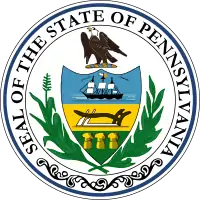| ||||||||||||||||||||
| ||||||||||||||||||||
 County results Thornburgh: 40-50% 50-60% 60-70% 70-80% Flaherty: 40–50% 50–60% 60–70% | ||||||||||||||||||||
| ||||||||||||||||||||
| Elections in Pennsylvania |
|---|
 |
|
|
The 1978 Pennsylvania gubernatorial election was held on November 7, 1978. Incumbent Governor Milton Shapp was constitutionally ineligible to run for a third consecutive term in office. Republican Dick Thornburgh defeated Democrat Pete Flaherty in the general election.
Democratic primary
Candidates
- Bob Casey, Auditor General (from Lackawanna County)
- Pete Flaherty, United States Deputy Attorney General and former mayor of Pittsburgh (from Allegheny County)
- Ernie Kline, Lieutenant Governor (from Westmoreland County)
- Jennifer Wesner, mayor of Knox (from Clarion County)
Campaign
The race began with a primary that slated an impressive field of candidates. Flaherty, the former Mayor of Pittsburgh who was known for providing a progressive challenge to urban machine politics, bested State Auditor General Bob Casey, who had lost the Democratic nomination for this office twice before. Casey's campaign was greatly hurt by the presence of another Bob Casey who was running on the ballot for Lieutenant Governor; voters believed they were selecting a ticket of Flaherty and the Auditor General when they chose the Pittsburgh teacher as the Democratic running mate. Lieutenant Governor Ernie Kline, who was frequently known as "assistant governor" during his time in office due to his policy skills, was endorsed by outgoing governor Milton Shapp, but finished a distant third.
Results
| Party | Candidate | Votes | % | |
|---|---|---|---|---|
| Democratic | Pete Flaherty | 574,899 | 44.89% | |
| Democratic | Bob Casey | 445,146 | 34.76% | |
| Democratic | Ernie Kline | 223,811 | 17.48% | |
| Democratic | Jennifer Wesner | 36,770 | 2.87% | |
| Total votes | 1,280,626 | 100.00% | ||
Republican primary
Candidates
- Bob Butera, former State House Minority Leader (from Montgomery County)
- Henry Hager, State Senate Minority Leader (from Lycoming County)
- Alvin Jacobson, a disabled former soldier (from Adams County)
- David W. Marston, former U.S. Attorney for the Eastern District of Pennsylvania (from Montgomery County)
- Arlen Specter, former Philadelphia District Attorney (from Philadelphia County)
- Dick Thornburgh, former U.S. Attorney for the Western District of Pennsylvania (from Allegheny County)
- Andrew Watson
Campaign
Thornburgh's win came over the Republican leaders of both houses of the state legislature (House Minority Leader Bob Butera and Senate Minority Leader Henry Hager), as well as a former US Attorney, Dave Marston. Former Philadelphia District Attorney and future senator Arlen Specter was considered the front-runner in the months preceding the primary, but the moderate urban Republican's campaign faded as Thornburgh presented himself as a leader that could bridge both wings of the party.[2]
Results
| Party | Candidate | Votes | % | |
|---|---|---|---|---|
| Republican | Dick Thornburgh | 325,376 | 32.63% | |
| Republican | Arlen Specter | 206,802 | 20.74% | |
| Republican | Bob Butera | 190,653 | 19.12% | |
| Republican | David W. Marston | 161,813 | 16.23% | |
| Republican | Henry Hager | 57,119 | 5.73% | |
| Republican | Andrew Watson | 48,460 | 4.86% | |
| Republican | Alvin Jacobson | 7,101 | 0.71% | |
| Total votes | 997,324 | 100.00% | ||
General election
Candidates
- Pete Flaherty, United States Deputy Attorney General and former Mayor of Pittsburgh (Democratic)
- Running mate: Robert P. Casey, teacher
- Lee Frissell (Consumer)
- Running mate: Betty Burkett
- Dick Thornburgh, former US Attorney (Republican)
- Running mate: Bill Scranton III, newspaper publisher and son of former governor Bill Scranton
- Mark Zola (Socialist Workers)
- Running mate: Naomi Berman
Campaign
Flaherty out-polled Thornburgh by double-digit margins for much of the campaign, but the Republican candidate used highly effective strategies to close the gap in the weeks leading up to election night. Thornburgh was successful in recruiting suburban moderates, as fellow moderate Republican Specter encouraged his metro Philadelphia supporters to rally behind Thornburgh. In contrast, the liberal Flaherty had trouble reaching out to conservative Democrats outside of his Western Pennsylvania base, a problem hindered by Casey's tepid support for the candidate over the lieutenant gubernatorial issue. Thornburgh also aggressively courted traditionally Democratic-leaning groups and gained the endorsements of the NAACP and several labor unions. Democratic support slowly waned under this strategy, which allowed Thornburgh to take a close victory.[2]
Results
| Pennsylvania gubernatorial election, 1978[4][5] | |||||
|---|---|---|---|---|---|
| Party | Candidate | Running mate | Votes | Percentage | |
| Republican | Dick Thornburgh | Bill Scranton III | 1,996,042 | 52.54% | |
| Democratic | Pete Flaherty | Bob Casey | 1,737,888 | 46.44% | |
| Socialist Workers | Mark Zola | Naomi Berman | 20,062 | 0.54% | |
| Consumer | Lee Frissell | Betty Burkett | 17,593 | 0.47% | |
| Write-ins | Write-in | 384 | 0.01% | ||
| Totals | 3,741,969 | 100.00% | |||
| Voter turnout (Voting age population) | 64.60% | ||||
Notes
- ↑ "Our Campaigns - PA Governor - D Primary Race - May 16, 1978".
- 1 2 Kennedy, John J. (2006). Pennsylvania Elections: Statewide Contests From 1950-2004. University Press of America. ISBN 9780761832799.
- ↑ "Our Campaigns - PA Governor - R Primary Race - May 10, 1994".
- ↑ The Pennsylvania Manual, p. 728.
- ↑ The Pennsylvania Manual, p. 727.
References
- Ackley, Gayle; Arcuri, Patricia D, eds. (1979). The Pennsylvania Manual. Vol. 104. Harrisburg: Pennsylvania Department of General Services.
.jpg.webp)
_(cropped).png.webp)